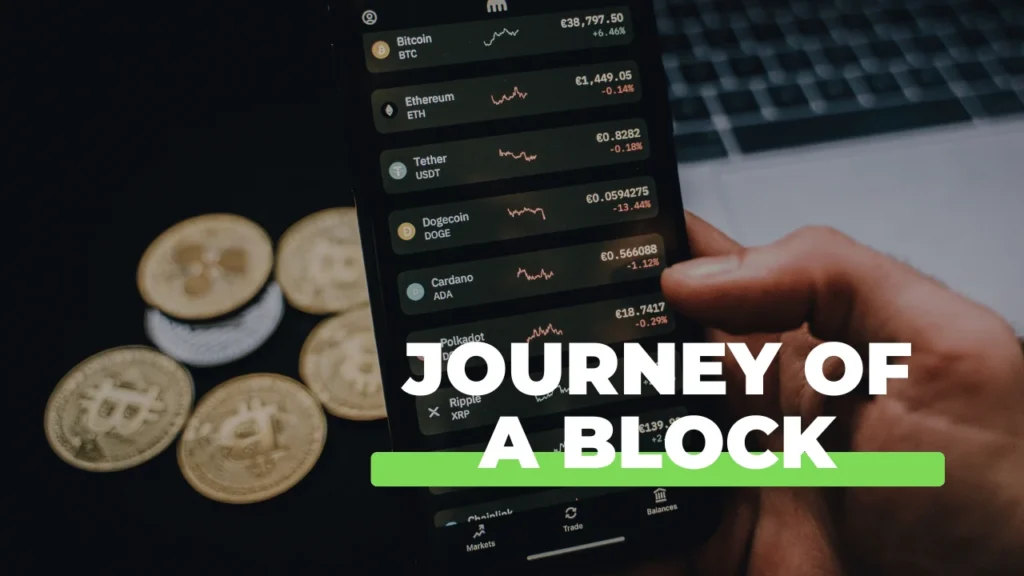With its revolutionary take on money, Bitcoin has become a beacon of light in the ever-changing realm of digital currency, captivating both users and investors. The concept of “mining,” What is the process of creating bitcoin popularly known as?, is fundamental to its appeal. This fascinating and complex procedure is the lifeblood of the Bitcoin ecosystem since it not only processes transactions and ensures the network’s security but also creates new bitcoins.
What Bitcoin Mining Entails?
Bitcoin mining is essential to the Bitcoin network because it verifies transactions to make sure they are legitimate and secure and because it creates new bitcoins to keep the currency flowing steadily. Mining, at its heart, is an example of the efficacy of state-of-the-art technology and contemporary cryptographic methods.
Cryptographic Puzzles

Solving Complex Problems
Cryptographic puzzle solving is at the heart of Bitcoin mining. These puzzles are intentionally difficult so that solving them will take a lot of processing power. To improve the efficiency and security of the network, miners from all over the world compete to solve these puzzles as quickly as possible.
Role of Specialized Hardware
Regular computers just can’t handle the computational demands of mining due to the intricacy of these puzzles. As a result, hardware like ASICs (Application-Specific Integrated Circuits) has emerged specifically for the purpose of Bitcoin mining. The mining process becomes more feasible with the help of these powerful machines, which improve the efficiency of solving cryptographic puzzles.
Network Security
Miners are essential to the Bitcoin network’s security because they engage in the mining process. It becomes more difficult for bad actors to alter or compromise transaction data as each puzzle is solved, strengthening the network’s security.
Verifying Transactions
A crucial aspect of Bitcoin mining is validating transactions on the blockchain. To keep the network trustworthy and reliable, miners check that transactions are legitimate and don’t involve double spending.
Birth of New Bitcoins
The creation of new bitcoins can only be accomplished through mining. Newly created bitcoins are given to miners when they solve a puzzle and validate a block of transactions. This incentive does double duty: it pays miners for their work and adds bitcoins to circulation at a steady, predetermined rate.
Journey of a Block

Crafting a New Block
Miners are able to add new blocks of transactions to the blockchain when they successfully solve cryptographic puzzles. Maintaining the growth and integrity of the Bitcoin ledger relies on this process.
Rewarding the Miners: Block Rewards
A block reward greatly increases mining’s appeal. Miners are incentivized to contribute their computational resources to the network by offering a reward that consists of newly created bitcoins and transaction fees.
Halving Event
The block reward is subject to a halving event, which reduces the amount of bitcoins given to miners by half, around every four years. A crucial aspect that supports Bitcoin’s value and allure is its scarcity, which this event guarantees.
Maintaining the Ledger
The integrity and veracity of the blockchain are strengthened with every additional block. Important to this process, miners check each transaction for authenticity to keep the network secure and avoid fraud.
Evolution of Mining From CPUs to ASICs
CPU Mining
Regular CPUs could mine Bitcoin when it was young. During this time, mining was accessible to almost anyone with a computer, which contributed to the growth of a strong community and a decentralized system.
Rise of GPU Mining
As the network expanded, miners started looking for ways to mine more efficiently, which led to the adoption of GPUs. As the next step in mining technology, GPUs proved to be far more efficient than CPUs.
FPGAs and the Quest for Efficiency
In an effort to achieve even higher levels of efficiency, Field-Programmable Gate Arrays (FPGAs) were employed. These provided superior performance compared to GPUs, but were far more affordable than the initial ASICs. FPGAs were a compromise, combining accessibility with efficiency.
ASIC Revolution
With the advent of ASIC miners, Bitcoin mining was completely transformed, thanks to their incredible efficiency. Concerns about mining centralization have arisen due to the high cost and specialized nature of ASICs, which are only affordable by individuals with significant resources.
Complex World of Mining Hardware
To successfully mine Bitcoin, you must choose the right hardware. If they want to maximize their profits, miners need to optimize their setup according to parameters like hash rate, energy consumption, and cost. The rise of advanced mining hardware, such as ASICs, mirrors the fierce competition and growing complexity of the Bitcoin mining industry.
Environmental Footprint of Bitcoin Mining
While Bitcoin mining is essential for creating new coins and keeping the network secure, it does come with some serious environmental consequences. Bitcoin mining has sparked a discussion about its environmental impact due to the significant amount of electrical energy it consumes due to the high demand for computational power.
Electrical Energy Consumption in Mining
Some worry about the impact on the environment due to the massive amounts of power needed for Bitcoin mining. Concerns regarding the environmental impact of digital currencies have been raised in light of the massive amounts of power consumed by mining operations, particularly those employing inefficient hardware.
Advancements in Energy Efficiency
A collective endeavor to enhance energy efficiency has been launched by the mining community in reaction to these worries. Modern ASICs are more powerful than their predecessors, but they use less power overall, which helps the environment.
Renewable Energy Solutions
Renewable energy sources are being used by an increasing number of mining operations. A more environmentally friendly way to mine Bitcoin is through the growing use of renewable energy sources like solar, wind, and hydropower.
Geographic Shift in Mining Activities
Mining operations have been spread out across different regions in an effort to find more affordable renewable energy sources. Sustainable mining operations are taking place in countries where renewable energy resources are plentiful and inexpensive.
Innovations in Bitcoin Mining Technology
Bitcoin mining technology has evolved in response to the incessant need for efficiency. In addition to improving mining’s profitability, these innovations try to solve the environmental and operational problems that miners encounter.
Liquid Cooling Systems
Liquid cooling systems have been implemented by certain operations to address the significant heat produced by mining hardware. When compared to conventional air cooling, these systems are far more efficient, meaning they use less energy and last longer for the hardware.
Mining Pools
There has been a dramatic increase in the prevalence of mining pools, in which participants pool their computing resources in an effort to solve puzzles more quickly. In addition to increasing productivity, this team effort makes mining more accessible to smaller miners by leveling the playing field.
Cloud Mining Services
Individuals can now take part in Bitcoin mining through cloud mining, eliminating the need to purchase costly hardware. Cloud mining allows users to rent processing power and mine bitcoins with little to no setup required; however, users should be cautious of scams and the reduced profit margins.
Future of Bitcoin Mining
The mining industry is constantly changing to keep up with Bitcoin’s development. The uncertain but potentially fruitful future of Bitcoin mining is shaped by factors such as technological progress, changes in global energy policy, and changes in market dynamics.
Adapting to Regulatory Changes
Worldwide, regulatory landscapes are changing; some nations are opening their doors to mining, while others are cracking down or banning it entirely. The future of Bitcoin mining hinges on miners’ capacity to adjust to these regulatory environments.
Alternative Consensus Mechanisms
Although Bitcoin is presently dependent on the energy-intensive Proof of Work (PoW) consensus mechanism, there is continuous investigation into alternative mechanisms like Proof of Stake (PoS). These alternatives may provide more efficient and environmentally friendly ways to keep the network running smoothly.
Decentralization and Security
Bitcoin mining’s foundational principles—security and decentralization—remain unwavering in the face of these obstacles. Improving these areas will probably be the focus of future mining strategies and technology, keeping Bitcoin a safe and accessible digital money.
FAQs
Q: How much electricity does Bitcoin mining consume?
A: Bitcoin mining consumes a significant amount of electricity, comparable to the annual energy usage of some countries. However, the exact figure fluctuates based on the efficiency of the mining hardware and the cost of electricity.
Q: Can Bitcoin mining still be profitable?
A: Yes, Bitcoin mining can be profitable, especially for operations that have access to cheap electricity and efficient mining hardware. Profitability also depends on Bitcoin’s market price and the mining difficulty.
Q: What is a Bitcoin halving event?
A: A Bitcoin halving event is when the reward for mining a block is cut in half. It occurs approximately every four years and is a mechanism to control the supply of new bitcoins, impacting miners’ profitability.
Q: Is it necessary to join a mining pool?
A: While not necessary, joining a mining pool can increase your chances of earning mining rewards, especially if you don’t have a large amount of computational power on your own.
Q: What are the environmental impacts of Bitcoin mining?
A: The primary environmental impact of Bitcoin mining is its high energy consumption, which can contribute to carbon emissions if the energy is sourced from fossil fuels. However, the increasing use of renewable energy sources by miners is helping to mitigate these impacts.
Also Read: How to Mine Bitcoin in India?
Conclusion
The fascinating and intricate process of Bitcoin mining is central to the Bitcoin network. In order to secure the network and create new bitcoins, it entails solving cryptographic puzzles, validating transactions, and adding new blocks to the blockchain. Highlighting the technological advancements and challenges within this space is the evolution of mining from CPU to ASIC. The future of this groundbreaking digital money is being shaped by mining, which is becoming more important as Bitcoin keeps growing. What is the process of creating bitcoin popularly known as?

Timothy Jensen is an expert writer who specializes in the world of cryptocurrencies, including blockchain technology and Bitcoin. He has a passion for explaining complex topics in an easy-to-understand way. Timothy’s work aims to demystify the digital currency landscape for his readers.

